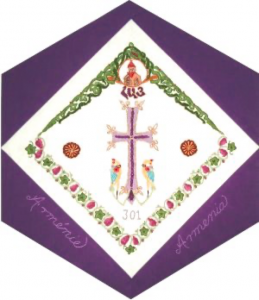Armenia

The Block
Armenia was the first country to adopt Christianity as its national religion in the year 301. Several symbols related to this theme are displayed on the block stitched by Anahid Jelderian and Arsho Zakarian. The ornate cross at the centre is stitched in purple, the royal colour worn by bishops and archbishops. The church dome depicts the unique architecture of Armenia and the embroidered design bordering the upper half of the block replicates Armenian church carvings. The two golden circles on each side of the cross are Armenian eternity signs symbolizing everlasting celestial life. Both the cross and the eternity signs are widely-used symbols in Armenian religious architecture. The letters HAY, embroidered in the Armenian alphabet above the cross, mean Armenian.
An important symbol in Armenian culture, the grape represents hospitality, agriculture and prosperity. This is exemplified by the grape leaf pattern embroidered in crewel and French knot stitching on the lower border of the block. The beautiful peacocks at the base of the cross are typical Armenian birds.
Cultural Profile
Armenia, a landlocked, mountainous country east of Turkey, is “acknowledged as one of the cradles of civilization.” It is a picturesque country with a long and cultured history. The official state language is Armenian, which uses a unique 38-letter alphabet dating back to the early 5th century, and which has no relationship to any other surviving language. Ethnic minorities, such as the Yazidis, also speak their own native tongues, mainly Russian and Kurdish.
Armenia’s rich culture has survived many hardships and evolved through a complex history. Armenia’s textile arts are varied and sophisticated. The needlelace is an artform that has endured through the centuries . It was part of most Armenian women’s lives, regardless of their social status. Complex embroidery has been used to decorate religious pieces, while the Marash style of embroidery produces delicate and striking pieces of blue, red or gold threads on dark backgrounds. Rug weaving, which was mostly a woman’s occupation, is still practiced today in vivid colours and broad geometric designs.
The architecture of Armenian churches, such as the one depicted in the block, has also widely influenced Western architecture and remains a testimony to the technical abilities of the Armenians. The churches always feature a pyramid shaped dome, are built in stone and can also withstand major earthquakes, as Armenia is in an active seismic zone. The outstanding stone carving techniques of Armenians can also be seen on kachkars. These steles act as a focal point of worship, memorials or relics, and display a cross and the eternity sign surrounded by exquisitely delicate carvings of leaves, animals or saints.
The haunting sounds of the Armenian duduk, a flute made of apricot wood, is central to traditional Armenian music and will be familiar to many movie watchers, as it often used in modern movie music. The duduk is generally played in pairs, one playing a drone and the other the melody. Other traditional instruments include the oud, a fretless string instrument close to the lute, and the kamancheh, a string instrument played with a bow that was traditionally played by the ashugs, the bards. The beautiful hymns of the Armenian Apostolic Church are sung by Armenians all over the world and evoke memories of their homeland.
Armenians are a resilient people with strong family and cultural ties, qualities that have been essential to the survival of these people and this small nation throughout its turbulent history, including the tragic Armenian Genocide which occurred during World War 1. Indeed, the economic contribution of Armenians scattered around the world has had a significant impact on the country’s recovery since it was granted its independence in 1991.
Over 55,000 Armenians are living in Canada according to the 2011 census, with immigration beginning as early as the 1890s. They have assimilated themselves well into the Canadian fabric, all the while working diligently to maintain their cultural heritage and identity. There are huge Armenian centres in Montreal and Toronto for example that include churches, full Armenian primary and secondary schools, a plethora of associate groups, and even weekly newspapers—all designed to assure the survival of the language, the culture and the faith.
Sponsor: Karla and Bruno Major
